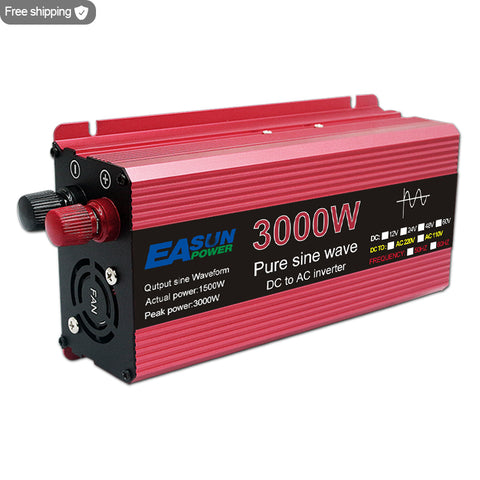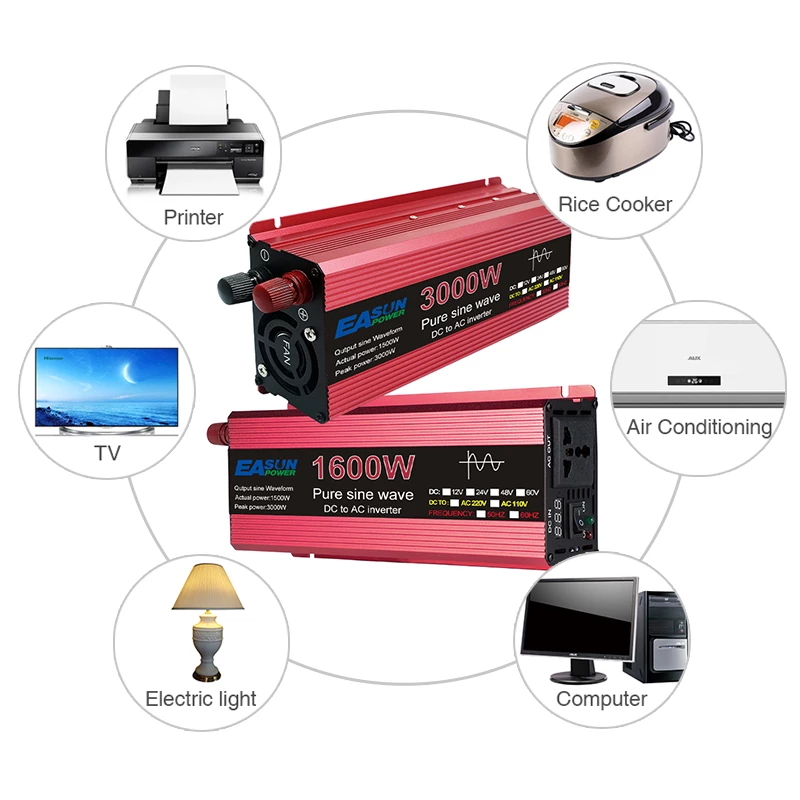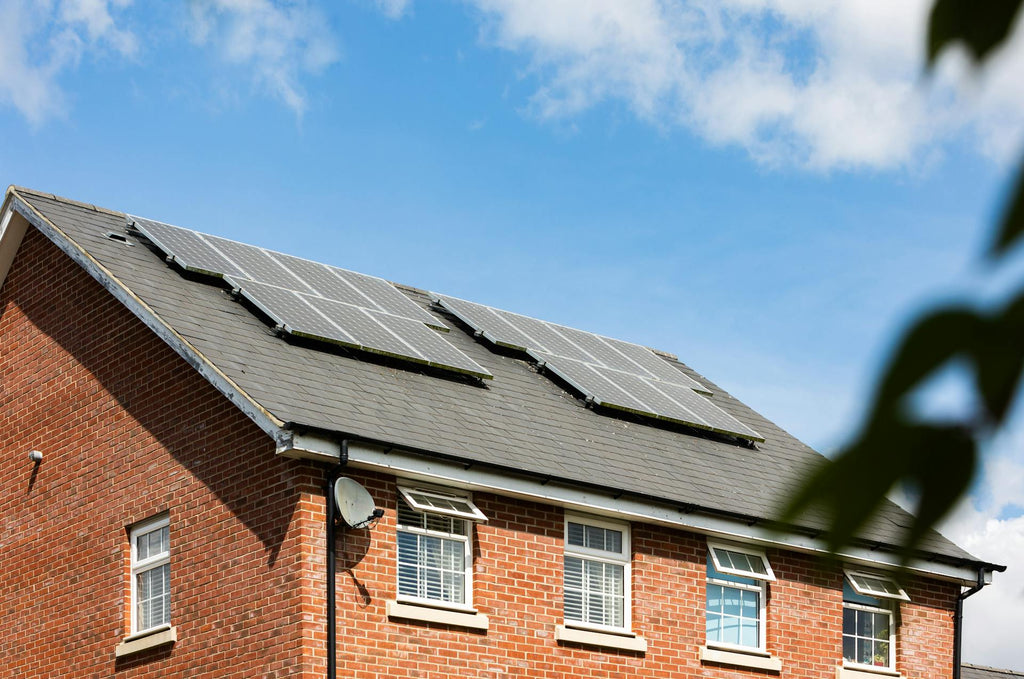
Pure vs. Modified Sine Wave Inverter: Key Differences Explained
|
Feature |
Pure Sine Wave Inverter |
Modified Sine Wave Inverter |
|
Waveform Quality |
Smooth and consistent, resembling household AC |
Abrupt, resembling a series of steps |
|
Device Compatibility |
Compatible with virtually all modern AC devices |
Some devices may run less efficiently or suffer damage |
|
Efficiency and Performance |
High efficiency, minimizing power loss |
Lower efficiency, potential for excess heat and higher operational costs |
|
Noise and Interference |
Low noise, suppresses electrical interference |
Can generate electromagnetic interference, affecting sensitive equipment |
|
Cost |
Higher upfront cost but can be offset by longer device lifespan and efficiency |
More economical upfront, but potential for higher long-term costs |
As European countries transition towards more sustainable energy solutions, the choice between these two types of inverters becomes paramount in ensuring the efficient and safe operation of household and professional electronics.
The post aims to shed light on the key differences between pure and modified sine wave inverters in an effort to help you find the right one for your needs. Whether powering sensitive medical equipment or simply running household appliances, the right inverter can significantly impact energy consumption, device longevity, and overall performance.
What Is a Pure Sine Wave Inverter?
A Pure Sine Wave Inverter transforms DC power into AC power with a wave output that precisely matches the smooth, natural oscillation of mains electricity. This seamless, consistent waveform is essential for the flawless operation of sensitive devices, ensuring they run efficiently without risk of damage or interference.

What Is a Modified Sine Wave Inverter?
A Modified Sine Wave Inverter, on the other hand, converts DC to AC power with a more rudimentary, step-like wave that approximates but doesn't fully replicate the smoothness of a natural sine wave. This simpler and cost-effective design may suffice for basic electrical needs but falls short for delicate electronics, potentially causing inefficiency or failure to operate.
Key Differences Between Pure vs Modified Sine Wave Inverter
Waveform Quality
- Pure Sine Wave Inverter: This inverter type generates an AC output that closely resembles what you would get from a standard household electrical outlet. The smooth, consistent wave ensures that devices operate as intended without stress or strain on their internal components. For instance, when powering a TV or fridge, a pure sine wave inverter maintains the integrity of the delivered power, eliminating risks of flickers or temperature fluctuations.
- Modified Sine Wave Inverter: Here, the waveform is more abrupt, resembling a series of steps rather than a smooth curve. This can be particularly problematic for appliances that rely on precise timing or operate at very high frequencies. For example, a digital clock may run faster or slower, and audio equipment might produce a hum due to the harmonics introduced by the stepped waveform.
Device Compatibility
- Pure Sine Wave Inverter: Virtually all modern AC devices can run safely and efficiently on pure sine wave power. This includes medical equipment that requires exact voltage levels and frequencies to operate correctly, ensuring patient safety and device accuracy.
- Modified Sine Wave Inverter: Some devices, especially those with capacitive or inductive loads like microwaves or motors, might not only run less efficiently but could also suffer long-term damage. The incompatibility stems from the inverter's inability to mimic the natural waveform of grid-supplied electricity, causing devices to misinterpret the power they receive.
Efficiency and Performance
- Pure Sine Wave Inverter: These inverters are designed to minimize power loss, converting DC to AC with high efficiency. This means more of your battery's stored energy goes towards running your devices rather than being wasted as heat. For instance, an inverter operating at 90% efficiency delivers more usable power, reducing the need for frequent battery recharges.
- Modified Sine Wave Inverter: Lower efficiency becomes evident when powering devices that demand a steady and uninterrupted flow of electricity. The inefficiency can manifest as excess heat, leading to higher operational costs over time. Devices like motors may run hotter and less efficiently, shortening their lifespan.

Noise and Interference
- Pure Sine Wave Inverter: These units are engineered to suppress electrical noise, ensuring a quiet operation conducive to both residential and professional settings. This feature is crucial for audio recording studios, where even minimal interference can degrade sound quality.
- Modified Sine Wave Inverter: The abrupt changes in voltage can generate electromagnetic interference, disrupting the functionality of sensitive equipment. Users may notice this as background noise on speakers or lines on TV screens, indicative of the inverter's inability to provide clean power.
Cost
- Pure Sine Wave Inverter: The sophistication required to produce a clean sine wave comes at a higher price point. However, the investment can be justified through the extended lifespan of devices powered by these inverters, coupled with the reduced risk of damage to sensitive electronics.
- Modified Sine Wave Inverter: These are more economical upfront, catering to users with less critical power needs or those powering simpler devices. While the initial savings are appealing, it's important to weigh the potential costs of inefficient operation or possible damage to connected devices over time.

How to Choose Between Pure vs. Modified Sine Wave Inverter
For general household use involving various sensitive electronic devices, a pure sine wave inverter is advisable to ensure safety, efficiency, and reliability. On the other hand, if your needs are more basic, such as powering simple tools or appliances without sensitive electronics, a modified sine wave inverter might suffice and save you money.
Final Words
By considering the key differences outlined above-waveform quality, device compatibility, efficiency, noise, and cost-you'll be well-equipped to make an informed decision that aligns with your power needs and budgetary constraints.
FAQs about pure sine wave vs. modified sine wave inverters
Q: What types of devices require a pure sine wave inverter?
A: Sensitive electronics like medical equipment, variable speed motors, and audio/video equipment typically require a pure sine wave inverter to operate properly.
Q: Can I damage devices by using a modified sine wave inverter?
A: Possibly, yes. The abrupt waveform of a modified sine wave inverter can cause excess heat, noise, and inefficiency in motors, microwaves, and other electronics. This may shorten their lifespan.
Q: How does a pure sine wave inverter produce a cleaner waveform?
A: Pure sine wave inverters use more sophisticated circuitry to produce a smooth, consistent AC output that precisely mimics the natural waveform of grid-supplied electricity.

Leave a comment